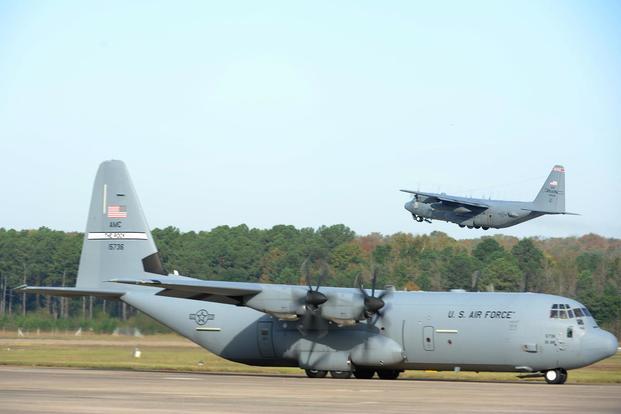Parts of South America have been underwater for weeks as heavy and torrential downpours have washed away city streets, buildings and, in some cases, entire villages in Peru, Ecuador and Colombia.
At the request of the Peruvian government, the U.S. Air Force on April 4 dispatched two C-130Js from Little Rock Air Force Base in Arkansas. For the past week, Capt. Patrick Steppe, instructor pilot with the 61st Airlift Squadron, and his crew have been up and down in the Hercules, moving hundreds of thousands of pounds of equipment and food to stranded or displaced families.
Two aircrafts' worth of pilots, co-pilots, loadmasters, maintainers and security forces are on the ground in Lima, where daily work has been to deliver beans, rice, mobile generators, school supplies and potable water.
The roughly 30 airmen are from the 61st and 41st Airlift Squadrons; 19th Security Forces Squadron; and the 34th Combat Training Squadron, which provides tailored joint mobility training to produce combat-ready airmen and soldiers.
"We load up the cargo and then take it out to different airfields in the north of the country," Steppe said in a telephone interview with Military.com on Monday evening.
Collectively, the units have loaded and moved 280,000 pounds of cargo, said Senior Airman Alexandra White, the 61st's mission loadmaster.
The Office of U.S. Foreign Disaster Assistance -- part of the United States Agency for International Development -- is supporting the United Nations and local non-governmental partners to provide safe drinking water, chlorination tablets, cleaning supplies, and hygiene kits, among other relief supplies, AMC officials said. USAID is also providing emergency response equipment, including water, water tanks, boats, and mosquito nets to hard-hit regions in Peru.
The U.S. -- with the help of Peruvian military authorities -- is headlining the mission, Steppe said, adding he's also seen Brazilian aircraft in the area. The crews fly to a few remote airfields per day, he said.
The use of the C-130J, which Little Rock transitioned to from the C-130H, has also been a step up in airlift effectiveness, added Tech Sgt. Joshua Jorgensen, a flying crew chief with the19th Aircraft Maintenance Squadron. The C-130J-30 Super Hercules variant -- not its J "stubby" cousin -- has a longer fuselage to transport cargo, and is faster and leaner in flight, he said.
The last C-130J-30 delivery for the 61st, which operates a fleet of 14 Super Hercules airlifters, was in June 2016, according to its manufacturer, Lockheed Martin Corp. The 19th Airlift Wing, which hosts the 61st, operates one of the Air Force's largest C-130J fleets, with 28 Super Hercules total, Lockheed said in a release.
"The aircraft are a lot more user friendly," Jorgensen said of upgrading from analog to digital interface in the plane. "It's flying faster, and we can deliver more cargo to anywhere it needs to be."
In the next couple of days, Steppe says the units will start delivering larger supplies, such as shelters.
"We go to the places with the best material handling equipment," said Steppe, referring to the use of forklifts to help them transfer supplies. Crews are moving roughly 25,000 to 35,000 pounds of cargo during their four-to-seven-hour work days, he said.
On the ability to provide relief to those affected by the flood, Steppe said, "The mission itself has been fantastic -- you can feel how cool it is to be involved in something like this."
"One of the most vital aspects of what we do is what I call "Gray Tail" diplomacy, AMC commander Gen. Carlton Everhart II told Military.com in a statement.
"What does that mean? In short, it means that anytime an Air Mobility Command aircraft lands in a nation abroad, it highlights the values and resolve of the United States."
The airmen will begin departing Peru around April 18, Steppe said.
-- Oriana Pawlyk can be reached at oriana.pawlyk@military.com. Follow her on Twitter at @Oriana0214.




























